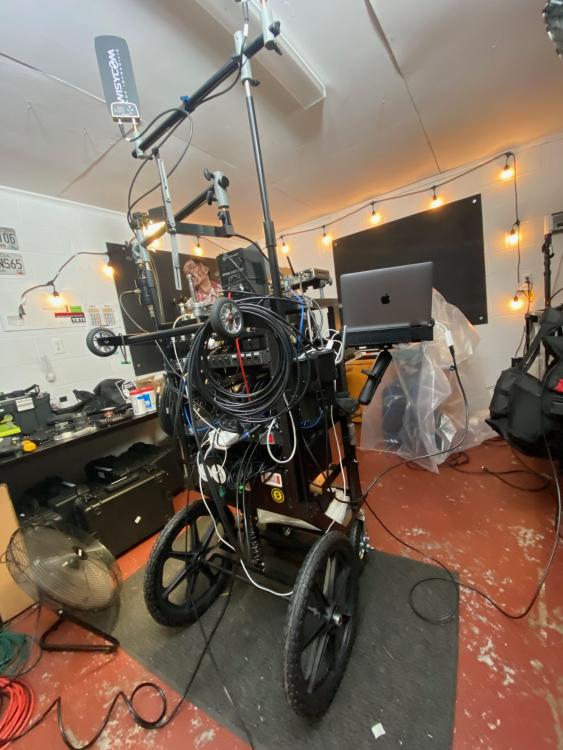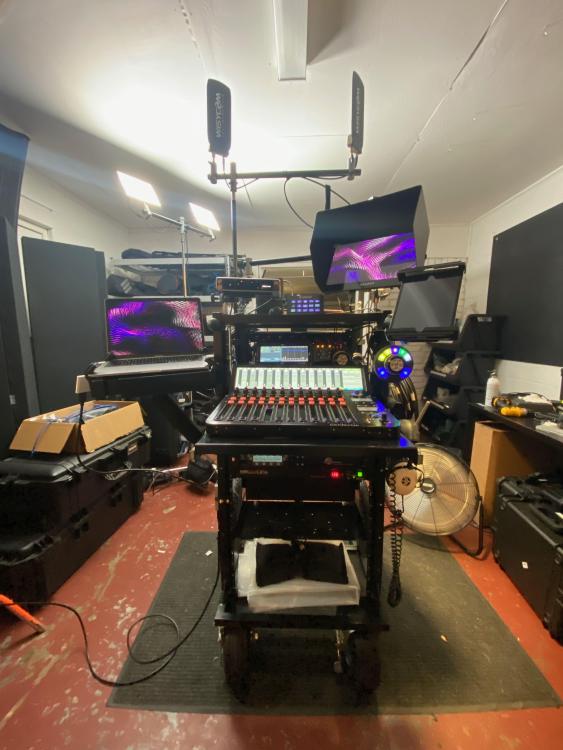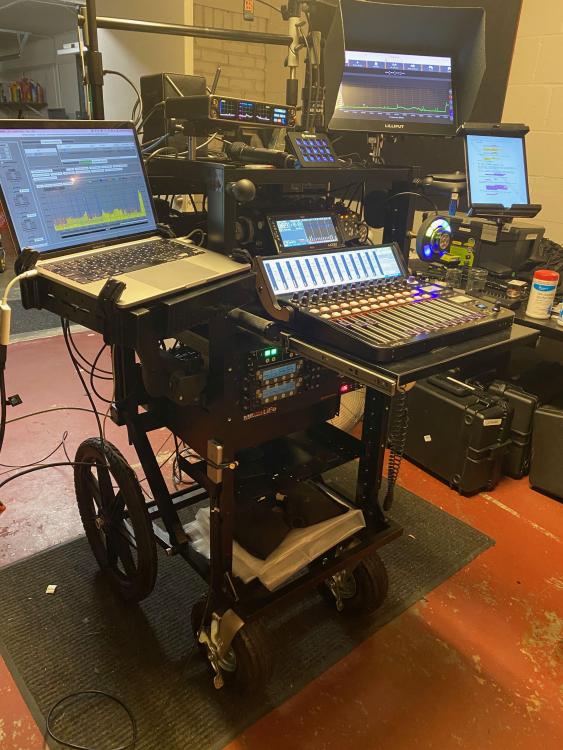-
Posts
281 -
Joined
-
Last visited
-
Days Won
5
Content Type
Forums
Gallery
Store
Everything posted by Michael Wynne
-
bringing this very old thread back to life! For some reason my CW version has more low end then my P Version? Not sure if there possibly set up wrong at the factory.
-
The DSSM will be an excellent addition to my D2 wireless eco system. I too what would love remote control if TX’s . I’m betting that WMAS with its 6 MHz bandwidth will the be future for remote control for not only Lectro but all manufacturers in the next couple years and all those 2.4 ghz controlled systems will be outdated. And if/when we do see a WMAS compatible system with remote control Lectro’s track record shows that these D2 TX’s will most likely work with the next gen RX’s maximizing your investment.
-
Let's not forget the goals of a receivership, meaning things are most likely not over. Hopefully just changing over hands. The Aaton brand and its products has a very high value and a loyal user base who are willing to make the investment for the type of quality they provide.
-
Like LA & NY, the Atlanta market is at a stand still for TV & Film narrative work. Local Unions are literally distributing food to help keep financially desperate members afloat. IATSE members are loosing their homes, their health insurance and are under incredible mental and emotional pressure. Some are quietly working through outside channels such as BET, Tyler Perry, reality TV and non studio affiliated indies on the interim but those percentages of mixers are very small. For most of us deeply embedded in the traditional channels, it’s a good time to do all that stuff you said you would do once you had some time off and then some. Hoping this gets resolved soon!
-
Thought I'd share my build out progress for my standing cart with you guys! Please excuse the cabling not being fully finished but it's a work in progress.
-
.jpg.60deb0716219777743dadbbc5c367e0c.thumb.jpg.1c9a3a88e16c9817f9ba0b039743d08a.jpg)
New cart build. Inovativ Deploy with some customization.
Michael Wynne replied to Phil Palmer's topic in Equipment
Beautiful cart design Phil! There’s a mixer here in Atlanta who’s built one very similar to this with the same Innovativ base and I’ve also been considering going this route. -
.jpg.60deb0716219777743dadbbc5c367e0c.thumb.jpg.1c9a3a88e16c9817f9ba0b039743d08a.jpg)
Digital UHF wireless from Deity announced: Theos
Michael Wynne replied to Jim Feeley's topic in Equipment
In the US you’re looking at 550-608 MHz plus the guard band/duplex gap. According to the rep Andrew in the Gotham NAB video there are no current plans to make 941 MHz in the US available. So you’re looking about 68 MHz ( approx 2 Lectro single blocks 22/23 range ) Anything below 550 Mhz is not avail because of the RF chip they chose due its availability in manufacturing and getting to market -
Very nice set up Shane!
-
.jpg.60deb0716219777743dadbbc5c367e0c.thumb.jpg.1c9a3a88e16c9817f9ba0b039743d08a.jpg)
Sound Devices, My A20 Mini review. Love it or leave it?
Michael Wynne replied to Michael Wynne's topic in Equipment
When I wrote this review, I hadn’t actually had the opportunity to use them on a film set so the practicality of power management and RF robustness were still in question. But now I’ve been able to utilize them on a TV narrative workflow with the A20RX for about three months now along side my mixed bag of Lectro digital / digital hybrid. We typically always cook them at 20mw, and the gain forward is a life saver since I’m very particular about transmitter gain staging and often utilities get in a hurry and don’t remember to set them where I request. What’s interesting is I switched to all Nimh for my Lectros as well and the magic number for all talent batt changes is every 3 hours around the house. We have ample time to change batts in between a scene or lighting set up even with big page count days. Nobody ever complains, it’s never an issue and nobody is ever waiting I do use low voltage alarms on my Cantar Mini hydra for my A20RX & timers for my Lectro which are helpful as well. I have two of the battery doublers if I absolutely need it but I doubt I’d rarely deploy, But I’d go with AAA lithium’s first if needed. As far as RF robustness there as every bit of good as my Lectro digital. I will say however that the A20 mini can be a bit more prone to RF body absorption, so transmitter placement is key, -
.jpg.60deb0716219777743dadbbc5c367e0c.thumb.jpg.1c9a3a88e16c9817f9ba0b039743d08a.jpg)
Sound Devices, My A20 Mini review. Love it or leave it?
Michael Wynne replied to Michael Wynne's topic in Equipment
Hi Martin, I checked out the SK 6212 and it looks like a great piece of kit! In regards to your comment, I also am a big fan of modularity and it's a must have in my kit. I agree it's substantial investment for an additional Nexus and I also feel like it would be necessary on a cart if it was your primary system. But you also would gain the additional use of simultaneous bands which could be advantageous for larger channel counts. I'm currently using A20RX's on my small cart, and plan on installing my Nexus on the big cart for my next show. I'll also be using my Lectro digital along side for now, as I need much more than what SD has to currently offer such as plant TX's with 48v, boom plug ons, handhelds, higher power TX's etc. I will say that I don't mind the power on the A20 mini and management on set is not as daunting as one may think. However I'm in narrative and we do have the opportunity to change batts. Also as Rich posted, Nexlink really takes power management to the next level and has been able to not have to change batts before lunch, etc. -
Nathan, maybe I’m not being clear. “ I wish the BNC Inputs and cascade out were both on the rear” Meaning 4 physical BNC connections on rear.
-
Theoretically yes, practically speaking in a fully coordinated RF workflow with COMS, IFB's, & 3rd Party Transmitter/RX's only time will tell. Also forget anything in the 1500Mhz band here in the US, I got the best FCC minds at 695 scratching their heads on how to get that licensed for a production sound mixer doing narrative work anywhere in the states and SD keeps it on tight lock down until you unravel the puzzle.
-
Thanks for sharing, nice to see a real photo of this that isn''t in a moody RGB dungeon with haze! LOL 🙂
-
Very excited about this product for many reasons, but if I had to to critique my initial thoughts are is I wish the BNC Inputs and cascade out we're both on the rear. I assume the thought was so bag users could utilize, but this makes cascading a bit awkward on the install on a proper sound cart, they could have made a bracket like they did for wifi for this purpose having both BNC's on the rear. If I was a bag user I would much prefer the A20RX slot mounts which I currently own and utilize on my second smaller stealth cart. Also my gut instinct is I think it's advantageous to have two of these on a cart. First reason is I'm a bit nervous about fitting 16 channels in one 24Mhz band, that seems a bit limiting for those of used to 470-608Mhz found on the other brands, Adding a second gives you about 24Mhz more, but once again the BNC situation is driving me nuts on how to accomplish a clean install.
-
I think the A20 Rx is the way to go in the bag to compliment the Nexus on the cart.
-
.jpg.60deb0716219777743dadbbc5c367e0c.thumb.jpg.1c9a3a88e16c9817f9ba0b039743d08a.jpg)
Sound Devices, My A20 Mini review. Love it or leave it?
Michael Wynne replied to Michael Wynne's topic in Equipment
A couple good range examples here for the A20 Mini & A20 RX in LR mode on some 1/4 wave whips. -
.jpg.60deb0716219777743dadbbc5c367e0c.thumb.jpg.1c9a3a88e16c9817f9ba0b039743d08a.jpg)
Sound Devices, My A20 Mini review. Love it or leave it?
Michael Wynne replied to Michael Wynne's topic in Equipment
I haven’t used them on a narrative film set yet, so I don’t have that feedback yet. But when the TX is off, the user should be able to extend those battery TRT’s by the exact amount of time they are off. -
.jpg.60deb0716219777743dadbbc5c367e0c.thumb.jpg.1c9a3a88e16c9817f9ba0b039743d08a.jpg)
Sound Devices, My A20 Mini review. Love it or leave it?
Michael Wynne replied to Michael Wynne's topic in Equipment
Providing you have Bluetooth range power off/on is instantaneous -
.jpg.60deb0716219777743dadbbc5c367e0c.thumb.jpg.1c9a3a88e16c9817f9ba0b039743d08a.jpg)
Sound Devices, My A20 Mini review. Love it or leave it?
Michael Wynne replied to Michael Wynne's topic in Equipment
Hi jobo, thanks for the feedback and also your valuable feedback on the D2 comparison. My first impression of the A20 mini transmitter audio converter and modulation quality was it was very good. But first impressions are not very conclusive. I’ll need to do some more testing with different mics before I really determine what I really think about it. I want to get some other mics & voices into play to see how things are really translating -
Bought a couple of the A20 TX’s along with the A20 RX. Been working on this review for a while, want to share Sound Devices A20, Love it or Leave it?
-
.jpg.60deb0716219777743dadbbc5c367e0c.thumb.jpg.1c9a3a88e16c9817f9ba0b039743d08a.jpg)
Burnout, stress, depression: experiences?
Michael Wynne replied to thenannymoh's topic in General Discussion
Oh how I do love JW Sound! Only here can you find threads like these. As I have some time off in between shows and am caring for my own state of mind it's so nice to read and relate! Cheers. -
So I’m being requested from dailies to work in pull up 48.048 / 24fps since the DP wants to shoot @ true 24fps to reduce the possibility of flicker with lighting set ups. We are not shooting on film and footage will be pulled down 1% along with sound to be edited and broadcasted at 23.98. The dailies company said this is somehow common with Canadian DP’s who feel this is a solution to mitigate flicker issues. So, The dailies company wants to modify my sound rolls and sample rate convert my Cantar X3 files back down with SD’s Wave agent before hitting editorial to get it all back down to 23.976 and assures me it will be seamless and not affect sound. What’s odd to me is there doing all this just to accommodate the possibility of flicker and it’s not even a heavy VFX show. I feel like this could create a whole heap of issues not only in my cart workflow with Dante sample rate sync with clocking and pro tools playback but it could also create unnecessary confusion down the line with audio post who will want to work with the original sound rolls.
-
Hi Everyone, I have what I hope is a simple technical question I was hoping to get assistance with. If I have a recorder in particular a Cantar mini running at 48.048khz sampling rate ( pull up work flow request ) and I have a mic pre amp with an AES output connected that does not have the pull up setting @ only 48khz ( i.e. Sonosax M2D2 ) are there any drawbacks to the AES signal. I'm hoping & assuming the M2D2 is receiving clock from the X3 by default via the AES signal, therefore the clock is resolved to 48.048khz and is therefore a non issue, or perhaps I'm missing something.
-
Use mine with a distro from a PSC 6 pack, performance is rock solid with digital hybrid.






